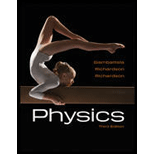
Concept explainers
(a)
An algebraic solution for
(a)
Answer to Problem 125P
An algebraic solution for
Explanation of Solution
The system is in equilibrium until the ladder begins to slip.
Write the expression for the Newton’s second law for the equilibrium.
Here,
Write the expression for
Here,
Put the above equation in equation (I).
The frictional force has its maximum possible magnitude at the person’s highest point.
Write the equation for the maximum possible magnitude of frictional force.
Here,
Put the above equation in equation (II).
The net external force on the system in the
Here,
Write the expression for
Here,
Put the above equation in equation (IV) and rewrite it for
Put the above equation in equation (III).
Choose the axis of rotation at the contact point between the ladder and the floor.
The net torque about the rotation axis is zero in equilibrium.
Here,
Write the expression for
Here,
Put the above equation in equation (VI) and rewrite it for
Put equation (V) in the above equation.
Conclusion:
Therefore, the algebraic solution for
(b)
Use the expression derived in part (a) to show that placing the ladder at a larger angle
(b)
Answer to Problem 125P
It is shown using the expression derived in part (a) that placing the ladder at a larger angle
Explanation of Solution
Refer to equation (VII) derived in part (a).
The value of
Conclusion:
Thus, it is shown using the expression derived in part (a) that placing the ladder at a larger angle
(c)
The maximum angle that enables the person to climb all the way to the top of the ladder.
(c)
Answer to Problem 125P
The maximum angle that enables the person to climb all the way to the top of the ladder is
Explanation of Solution
To climb up to the top of the ladder, set the value of
Put the above equation in equation (VII).
Rewrite the above equation for
Conclusion:
Given that the value of
Substitute
Therefore, the maximum angle that enables the person to climb all the way to the top of the ladder is
Want to see more full solutions like this?
Chapter 8 Solutions
Physics
- 3. If the force of gravity stopped acting on the planets in our solar system, what would happen? a) They would spiral slowly towards the sun. b) They would continue in straight lines tangent to their orbits. c) They would continue to orbit the sun. d) They would fly straight away from the sun. e) They would spiral slowly away from the sun. 4. 1 The free-body diagram of a wagon being pulled along a horizontal surface is best represented by A F N B C 0 Ꭰ FN E a) A b) B c) C app app The app 10 app d) e) ס ח D E 10 apparrow_forwardPls help ASAParrow_forwardPls help asaparrow_forward
- Pls help asaparrow_forwardThe acceleration of an object sliding along a frictionless ramp is inclined at an angle 0 is 9. a) g tano b) g cose c) g sino 10. d) g e) zero A 1.5 kg cart is pulled with a force of 7.3 N at an angle of 40° above the horizontal. If a kinetic friction force of 3.2 N acts against the motion, the cart's acceleration along the horizontal surface will be a) 5.0 m/s² b) 1.6 m/s² c) 2.4 m/s² 11. d) 1.0 m/s² e) 2.7 m/s² What is the net force acting on an object with a mass of 10 kg moving at a constant velocity of 10 m/s [North]? a) 100 N [North] b) 100 N [South] 10 N [North} d) 10 N [South] e) None of these.arrow_forwardModified True/False - indicate whether the sentence or statement is true or false. If the statement is false, correct the statement to make it true. 12. An object in uniform circular motion has a constant velocity while experiencing centripetal acceleration. 13. An object travelling in uniform circular motion experiences an outward centrifugal force that tends to pull the object out of the circular path. 14. An object with less inertia can resist changes in motion more than an object with more inertia. 15. For an object sliding on a horizontal surface with a horizontal applied force, the frictional force will always increase as the applied force increases.arrow_forward
 College PhysicsPhysicsISBN:9781305952300Author:Raymond A. Serway, Chris VuillePublisher:Cengage Learning
College PhysicsPhysicsISBN:9781305952300Author:Raymond A. Serway, Chris VuillePublisher:Cengage Learning University Physics (14th Edition)PhysicsISBN:9780133969290Author:Hugh D. Young, Roger A. FreedmanPublisher:PEARSON
University Physics (14th Edition)PhysicsISBN:9780133969290Author:Hugh D. Young, Roger A. FreedmanPublisher:PEARSON Introduction To Quantum MechanicsPhysicsISBN:9781107189638Author:Griffiths, David J., Schroeter, Darrell F.Publisher:Cambridge University Press
Introduction To Quantum MechanicsPhysicsISBN:9781107189638Author:Griffiths, David J., Schroeter, Darrell F.Publisher:Cambridge University Press Physics for Scientists and EngineersPhysicsISBN:9781337553278Author:Raymond A. Serway, John W. JewettPublisher:Cengage Learning
Physics for Scientists and EngineersPhysicsISBN:9781337553278Author:Raymond A. Serway, John W. JewettPublisher:Cengage Learning Lecture- Tutorials for Introductory AstronomyPhysicsISBN:9780321820464Author:Edward E. Prather, Tim P. Slater, Jeff P. Adams, Gina BrissendenPublisher:Addison-Wesley
Lecture- Tutorials for Introductory AstronomyPhysicsISBN:9780321820464Author:Edward E. Prather, Tim P. Slater, Jeff P. Adams, Gina BrissendenPublisher:Addison-Wesley College Physics: A Strategic Approach (4th Editio...PhysicsISBN:9780134609034Author:Randall D. Knight (Professor Emeritus), Brian Jones, Stuart FieldPublisher:PEARSON
College Physics: A Strategic Approach (4th Editio...PhysicsISBN:9780134609034Author:Randall D. Knight (Professor Emeritus), Brian Jones, Stuart FieldPublisher:PEARSON





